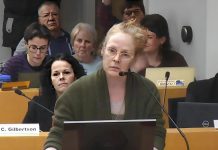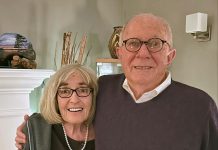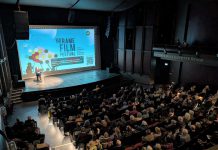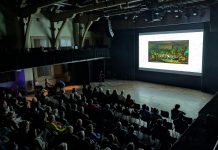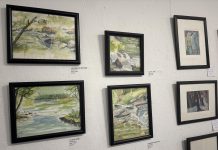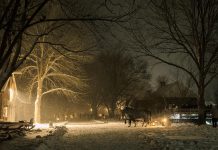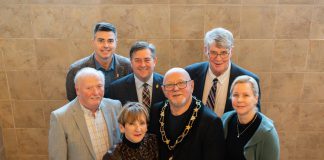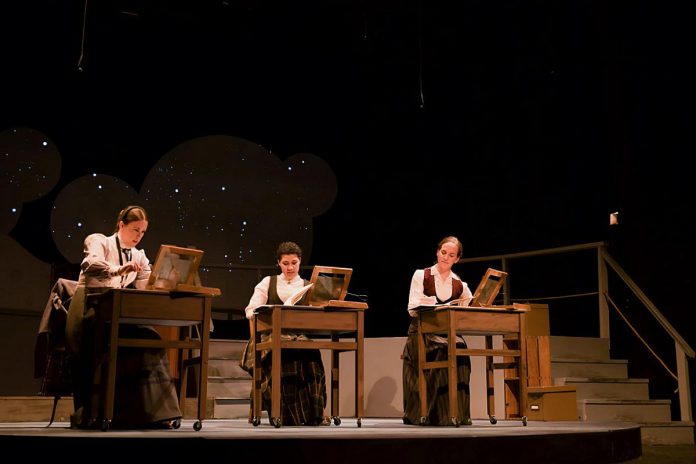
When it comes to live theatre, the actors on stage are only the tip of the iceberg of the crew of artists who put their expertise, passion, and time into telling a story and entertaining an audience.
“It doesn’t just happen,” says Bea Quarrie, director of Silent Sky, the Peterborough Theatre Guild’s winning entry in the 2024-25 Eastern Ontario Drama League (EODL) Full-Length Festival.
“It’s a fairly long process, and what you see is like looking at the credits at the end of the movie — there might be 10 actors and there would be 350 people involved in the making of the film itself.”
The extensive cast and crew who worked on stage and behind the scenes of Lauren Gunderson’s play, which ran from March 21 to April 5 at the Guild Hall in Peterborough’s East City, were honoured for their outstanding contributions with three awards and nine honourable mentions at the EODL awards brunch and ceremony, hosted by the Guild at Peterborough’s The StoneHouse Hall last Sunday (April 27).
At the brunch, more than 15 awards — many named after community theatre groups and supporters — were distributed between 11 productions that took place at community theatres across Ontario between November 2024 and March 2025 and were entered into the EODL Full-Length Festival.
For their work on Silent Sky, David Geene won the Peterborough Theatre Guild Award for Set Design, Kevin O’Neill (who played the character Peter Shaw) won the Arnold Connerty Adjudicator’s Award for Outstanding Male Actor in a Supporting Role, and Esther Vincent (the production’s lighting and projection designer) won the Deep River Players Award for Best Visual Presentation.
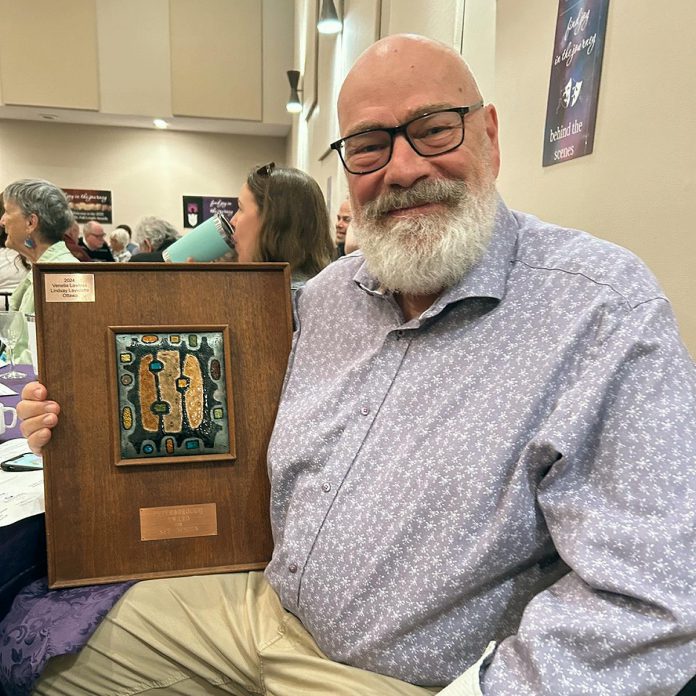
Quarrie received an honourable mention for the Trentonian and Tri-County Best Director Award, as did Jayne Martin for the John L. Walley Best Costuming Award, Lyndele Gauci for the Peterborough Theatre Guild Award for Best Use of Speech, Laura Lawson (who played the character Annie Cannon) for the Margaret White Acting Excellence Award for Best Female Actor in a Supporting Role, Kevin O’Neill for the Bancroft Theatre Guild Acting Excellence Award for Best Male Actor in a Supporting Role, and Esther Vincent, Eryn Lidster, and Marilyn Robinson for the Armagh Sifton Price Adjucator’s Award for Outstanding Technical Achievement.
Also nominated from Peterborough Theatre Guild were Eryn Lidster for an Adjucator’s Award for Outstanding Contribution, Lindsay Unterlander (as Henrietta Leavitt) for the Leonard Beaulne Memorial Trophy for Outstanding Actress in a Major Role, and Silent Sky for the Leslie M. Frost Award for Outstanding Production.
“We talk about how it’s in the integration and the holistic idea of the presentation that’s important, so that no one aspect of it overwhelms everything else,” says Quarrie. “It’s not all about the projections (for example), it’s about the world that it represents and that they bring to mind. It was a good coming together and good rousing conversation, so to have the adjudicator of the festival see that and acknowledge it was really gratifying.”
As award-winning set designer David Geene adds, even before the awards ceremony, “we knew this was a strong show and didn’t need anybody to tell us that.”
Silent Sky, one of the most widely produced plays in North America, tells the true story of 19th century astronomer Henrietta Leavitt. Working in the Harvard Observatory, Leavitt was not allowed near a telescope, yet that did not stop her from discovering how to measure the distance to stars in other galaxies — a breakthrough that provided a crucial tool for measuring vast cosmic distances, leading to the discovery of the expanding universe.
In the play, Leavitt finds herself attempting to balance her dedication to science with family obligations and the possibility of love.
“I was very impressed with the writing and this story is one about women who have never really received recognition for their work and particularly these scientists who worked at Harvard at the turn of the century,” says Quarrie. “They are so fundamental to how we see the cosmos today, so it was important to not only pay obeisance and respect to them for the work, but also to tell the story because it’s a rattling good yarn and a very interesting, dramatic story.”
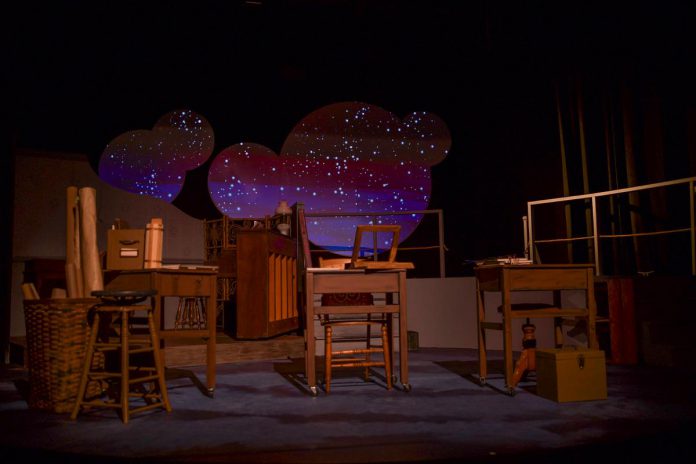
Ironically, during the run of Silent Sky, discoveries and all-new imagery from NASA’s James Webb Telescope were being published, which Geene says helped audiences connect with and understand Leavitt’s story.
“It’s the discoveries of Henrietta Leavitt that allowed people to measure those distances and understand that there was so much more beyond us,” he says. “I think for a lot of people that I spoke to there was that realization that the science we are now having unfold in front of us started 100 years ago with this woman.”
Beyond the scientific interest of the story, Geene identifies the “human stories” and relationships that interested audiences. From the Leavitt sisters having opposing dedications to science and religion, to the conflict of social and gendered expectations, Quarrie notes the play discusses “so many different topics that are very much at the surface at our thinking at the moment.”
These dichotomies — science versus religion, male versus female roles, domestic versus professional life — were all at the surface of Geene’s inspiration as he designed the award-winning set.
With windows on either side of the stage to represent the opposing sides of the church and school, the repeated use of circles to represent the Earth, planets, and cosmos, and a disco ball-like light to display stars throughout the theatre, every detail of the set was intentionally thought out.
“Because I’ve been an actor a lot and know what an actor needs, it’s a combination of considering that and realizing that things have to happen according to the script, and then asking the director what they want to happen,” explains Geene. “I did a lot of research on other set designs for the same show because there are images all over and it is the most produced production in North America, so there are other ideas out there, and it’s about harvesting those.”
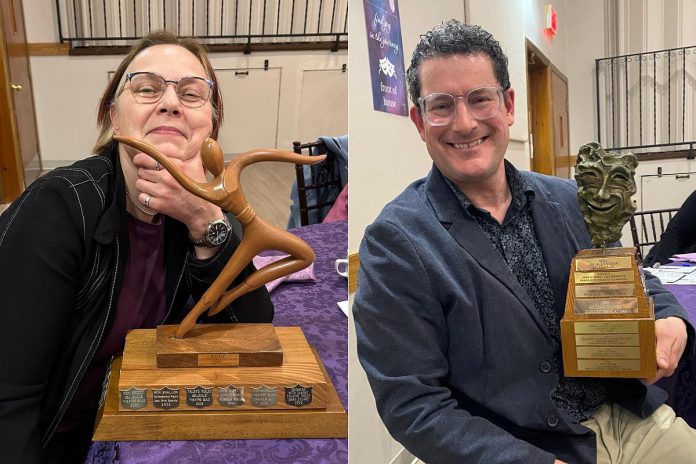
Quarrie adds that, in addition to expertly crafting the set, Geene did so in enough time so the set could be using during rehearsals. This, she adds, made her job easier given that the play features eight different settings, with each scene feeding into the next without pause. It also allowed for innovation in Esther Vincent’s award-winning lighting and projections, displayed on hanging spheres behind the set, which represented the view from the telescope.
“Having worked through commercial theatre, professional theatre, and amateur theatre, this was the first time in my life that I had a set on day one of rehearsals, and that was thanks to David, who not only designed it but helped construct it,” Quarrie says. “We could experiment and explore almost choreographic work that had to happen because the play is so cinematic.”
This approach, Geene says, allowed them to make changes as they went through the production and catch issues ahead of time — like a squeaky deck that overpowered the actors’ voices.
“Usually if you don’t get (the set) until two weeks before the show, that’s what you get, but this was more iterative,” he says. “It’s a long process and it’s back and forth between the creative team and the requests of the actors, and then finding props and set pieces.”
While Quarrie and Geene both acknowledge that it was an honour to have been acknowledged with the EODL awards, they agree the real reward comes in knowing their audience was entertained and enjoyed the story.
“For me, it’s putting on the best show that I can every night, and if it happens to be a festival entry and if it happens that the festival adjudicator is there for one of the nights, wonderful,” Quarrie says. “One of the ways I have of marking whether a production had an impact or not is if people go home talking about their lives as a consequence of having seen something that impacted them. That, to me, has value.”
“Going to the luncheon, the first benefit is meeting all these other theatre people from all over Eastern Ontario, and the second benefit is hearing the impressions of someone who saw all the shows,” adds Geene, noting he did not know the play was entered into the festival when he began designing the set.
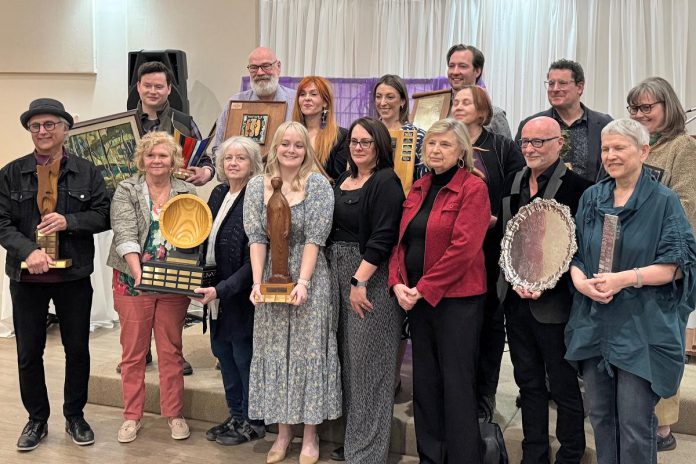
“It’s more about how we do the best job we can with the resources we have to make an impression on the audience, to attract actors, and to get people talking about it,” Geene says. “That’s what’s more important.”
Though he received the set design award and accepted it on behalf of the team, Geene assures that he will pass it around to different crew members during the year or display it in the Guild Hall to recognize there were a lot of individuals — from builders and painters to those who took down the set — who were essential to making the set and story come to life.
“It’s all collaborative,” he says. “What I envisioned in my head would be nothing unless they were there. This play had a lot going on and a lot of people did phenomenal work.”
This story has been updated with three additional honourable mentions the Peterborough Theatre Guild received during the EODL awards.


